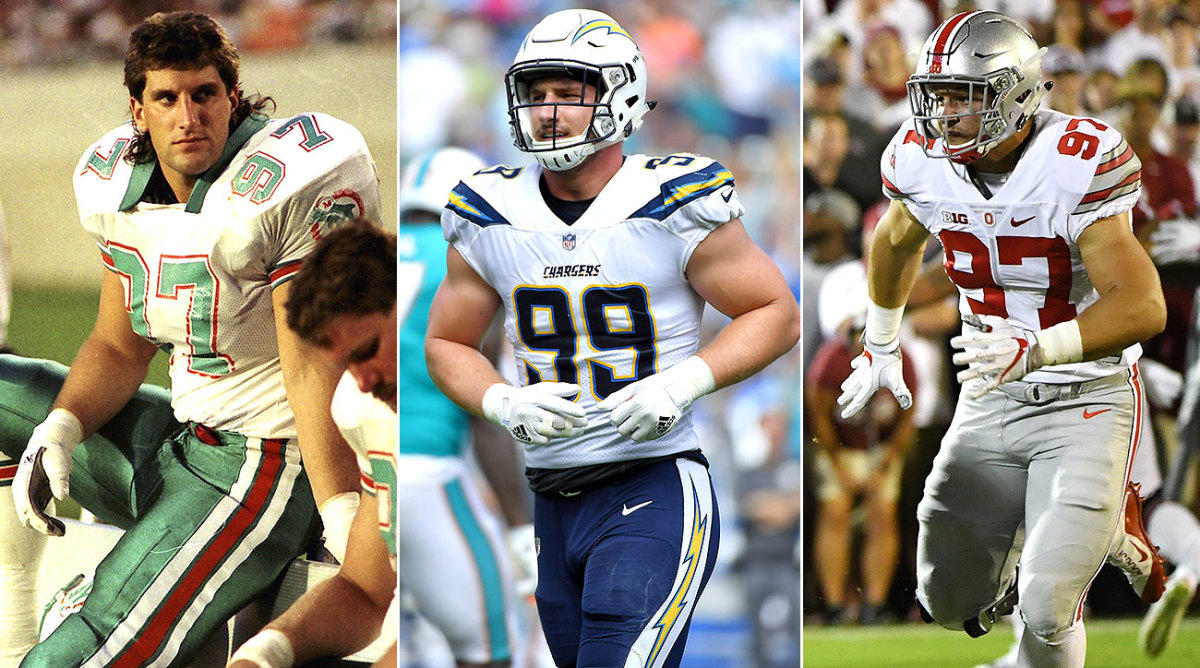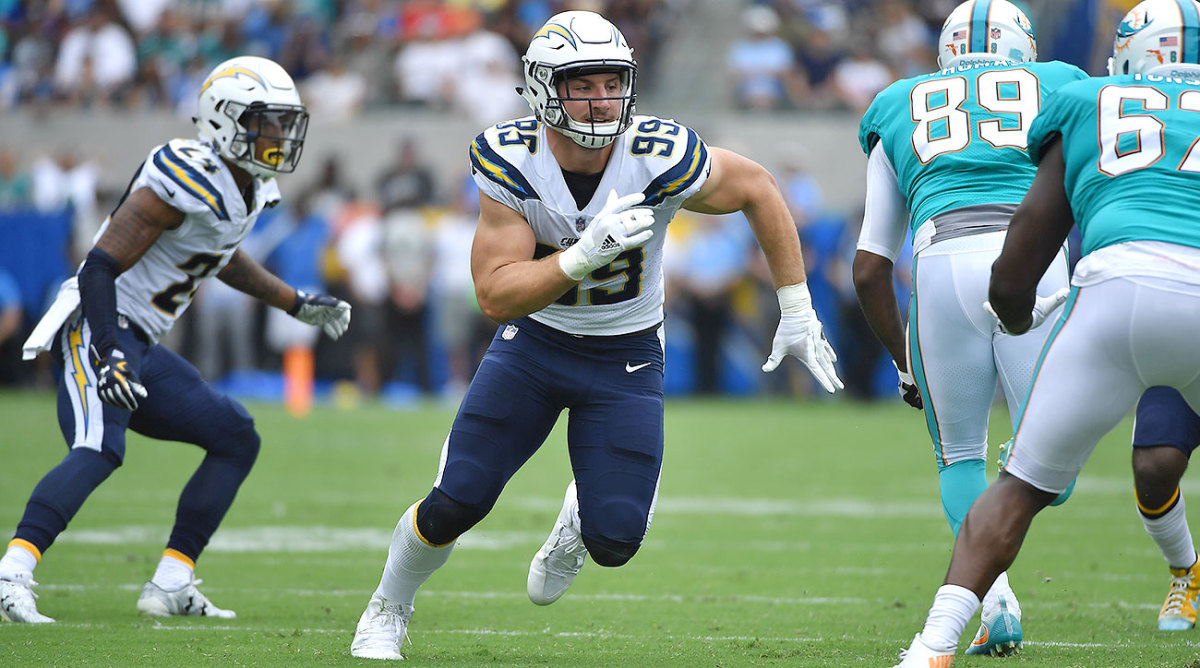The Bosa Family—Brothers Joey and Nick, Father John—Share a Passion for Pass-Rushing

If you’re in the market for an NFL pass rusher, call the Bosa family in Fort Lauderdale. John Bosa was the Dolphins’ first-round pick in 1987, and his former brother-in-law, Eric Kumerow, was Miami’s first-round pick the next year. John’s son Joey was the Chargers’ first-round pick last year, and Joey’s brother, Nick, will be a first-round pick some day. For now, he’s a burgeoning star at Ohio State.
Joey missed the first four games of his rookie year with a hamstring injury, but he spent the next 12 inducing whiplash at D-end. He finished with 10½ sacks in 12 games and won the league’s Defensive Rookie of the Year award. He’s the NFL’s Next Great Defensive Player, and we may be late with that declaration. Pro Football Focus determined that in the first three games of his career, he was the most productive pass rusher in the league, per snap, more so than even Khalil Mack or Von Miller. (By year’s end PFF had him as its fifth-ranked defensive end, but he generated pressure at a higher rate than any rookie in a decade of tracking players.) Joey, 22, entered this season feeling healthier, faster, more flexible and better prepared than he was last year, and yet he knows: He might not even be the best Bosa of his generation.
Nick Bosa is arguably the most promising defender on one of the nation’s most talented teams, and his older brother is already projecting him as a top five pick in the 2019 draft, following his junior year. “He could go this year,” Joey says, “except he’s not allowed.” In the matter-of-fact tone that is a family trademark, he adds, “If Nick sucked, I would tell you he sucked. But he doesn’t suck.”
Joey’s nickname is Big Bear, and Nick calls himself Smaller Bear. But at 6' 4" and 270 pounds, Smaller is basically the same size as Big (6' 5", 270). The brothers have similar athletic gifts, but Nick, 20, learned to apply them at a younger age because he was always copying his brother. Joey was not a starter at national powerhouse St. Thomas Aquinas High until he was a junior; Nick started as a freshman. Joey was a four-star recruit; Nick had five stars.
Football in America: Bridging Communities in the Bay Area
“Every time I think I’m better than him at something, he just flies right by me,” says Joey. “Ping-Pong. Lots of video games. We are obsessed with what we love, and what we love is football and our craft.”
Ohio State defensive line coach Larry Johnson, tellingly, is not hitting the brakes on the hype machine. Asked if Nick can be another Joey, as Joey suggests, he says, “That’s a true statement. He’s just young. But he’s got the tools to be really special.” NFL Network analyst Mike Mayock hasn’t yet watched much film on Nick—he’s a true sophomore, after all—but in the little he’s seen, “I just started laughing, because he looked like the same guy [as Joey].”
In addition to their more notable achievements, the Bosa boys have pulled off a rare sibling feat: They compete alongside each other more than against each other. They’re best friends and remain in daily contact. Nick “is one of very few people I can be my true self around,” says Joey. “Maybe the only person. I feel like he’s just another piece of me.”

The Matthews clan—Hall of Fame offensive lineman Bruce and three generations of Clays. The quarterbacking Mannings and Carrs. The punting Colquitts. Ronde and Tiki Barber. J.J. and T.J. Watt ... Cheryl and John Bosa did not set out to join these football families. They had other ideas for their boys, like baseball, soccer, tennis, golf, skiing. “I tried to keep them away from football as long as I could,” John says, but they begged to play, so Mom and Dad let Joey give it a shot when he was eight. Nick, who is 27 months younger, threw a temper tantrum, telling his parents, “If you don’t let me play too, I’m going to die.” (That may, in fact, have been true. Back then, the boys were spending a lot of their time in the backyard playing Kill the Man with the Ball. In football, at least, the goal is merely to maim.)
Nick slept with a football every night and wanted to play every day, and so his parents finally relented. At the boy’s first practice he was plugged in on offense. He tugged on a coach’s shirt and asked to switch to defense, like his dad. Nick was seven. He has stayed on that side of the ball ever since.
Even then he had an instinctive understanding of how to use leverage and technique to get past an offensive lineman. Cheryl says Nick was “a savant” from the beginning. “People were like, What’s happening here?”
Nick says, “It was just simple for me.”
Football began to take over the Bosas’ lives only because that’s what the boys wanted. Cheryl, a real estate agent, says she would have provided the same support “if it was piano lessons. It didn’t matter. It’s their passion.” When Joey and Nick were in high school, John would wake them at five for breakfast and their morning workout, and they never complained.
“I swear, not one time,” says John, who works in commercial real estate. “And football is the worst sport to practice. Baseball practice is a blast. Football practice is a grind. These guys have embraced it. You can’t teach that. Parents who push, push, push ... I’ve seen it—the kids go the other way. If it’s not in their heart, it’s just not going to work out.”
Even as Joey and Nick excelled, their parents stayed level, didn’t get caught up in the hype. When Joey started high school, John imagined his son might one day earn a college scholarship. An offer from Alabama came the next year. And if Joey could do it, there was no doubt Nick would too. (Cheryl and John divorced when Joey was in junior high school, but the boys have remained their priority; John posed on Cheryl’s patio for a photo accompanying this story, and they interviewed agents for Joey together.)
Joey and Nick fought plenty when they were younger. They didn’t truly become friends until they played together for one season, in the fall of 2012, at St. Thomas Aquinas—Joey as a dominating defensive end, Nick as an undersized but highly effective D-tackle. John would sit in the top row, “as far away from the other parents as I could get.” He didn’t want to hear anybody yelling at his kids.
The boys may have wanted to play football because their father had, John admits, but “ultimately, they’re just really good. When you have the genetic gifts they had ... they just loved it. It’s a lot of fun to knock the crap out of people.”
He pauses. “I miss it.”
John Bosa is an American oddity: He reached the highest level in his field, defying astronomical odds, only to be labeled a failure. The Dolphins drafted him with the 16th pick out of Boston College, and he started just 21 games. If he is remembered at all, it’s as a bust.
He politely disputes that label. In his second NFL season a guard dived at his left knee—legal at the time—and John tore three L’s: ACL, MCL, PCL. “That really was the end of my career,” he says. “I didn’t know it, but I never came back from that.” Technically he did come back, but he wasn’t the same player; his first step was not as quick. In his fourth season his right knee went out, and that was the end of that.
“The transition from John Bosa the football player to just John Bosa was a very difficult one,” he says, but he avoided traps that snare so many former players in that position. He did not, for example, exaggerate his gifts into a giant what-might-have-been. He believes he would have had a nice, long career if he’d stayed healthy, but he also says, “I was an overachieving guy. No one outworked me. But I didn’t have the total package that [Nick and Joey] have. I didn’t have that type of athleticism. I was more of a grinder.”
That John did not try to recapture his greatness through the boys was just as well, because the game has changed since his playing days. In the 1980s defensive ends trained like weightlifters, more geared toward lifting a Porsche than running like one. And pass-rushing moves of that era were relatively simple: the bull rush, the club-and-rip, the spin. Quarterbacks took seven-step drops, which gave pass rushers more time to reach them.
Today’s quarterbacks pass more often and take shorter drops, and defensive ends line up wider. Johnson, Ohio State’s line coach, says “the hips and the hands are the most important things now. If you can flip your hips in a pass rush”—or point your hips toward the QB—“you have a great chance to be successful.” (If John Bosa ever heard the phrase flip your hips in his days, it would have been at a Miami nightclub.) Today’s rushers, Johnson says, shed blockers with “violent” hands—they initiate the fight instead of avoiding it.
NFL Power Rankings Poll: Patriots Finish Regular Season On Top, As for the Browns . . .
That tutelage, John says, is why “Joey and Nick were better football players as freshmen at Ohio State than I ever was.” He knows he couldn’t have taught his boys to play this way even if he’d wanted. It would be like Orville Wright trying to teach somebody to fly a 747.
Joey, for one, has become a hips-and-hands evangelist, convinced that Johnson’s techniques are revolutionizing the position. And he may be the one who proves it. In his rookie season he drew comparisons with J.J. Watt—another tall, white pass rusher from the Big Ten with a talented younger brother—but Joey points out that they are “pretty significantly different players.” Watt, after all, weighs 290 pounds and could be an All-Pro defensive tackle if he played there. Says Joey, “[Watt] is a freakin’ animal, moving guys out of the way. I like to think I combine finesse and power.” (Not that Joey’s lacking in moving-guys-out-of-the-way prowess. Says Mayock, “When he gets his hands on a player’s body, it looks like he’s got his hands on a steering wheel.”)
What Watt and Bosa have in common is relentlessness. As a rookie Bosa earned a reputation for playing hard on every snap, which was especially impressive considering that he’d battled tendinitis in one knee for three years and that his lower back hurt enough that he had to stand up in the middle of meals to stretch. But he came to trust one of the Chargers’ strength coaches, Todd Rice, so much that when the team cleaned out its staff in January, Bosa put Rice on his personal payroll. He plans to follow Rice’s biomechanics-based workouts, emphasizing “joint integrity and elasticity,” until he retires.

It’s easy to confuse Big Bear and Smaller Bear, especially with Nick’s wearing Joey’s old number 97 Buckeyes jersey. (John also wore 97 at B.C. and in Miami; Joey has switched to 99.) They each love their labor more than its fruits; as Cheryl says, “They like the results of it, but they don’t like the pomp and circumstances of it.” They train together in the offseason and play Rocket League on PlayStation 4 together and seem exactly alike. But, of course, no two people really are.
“Joey has a shorter fuse,” Cheryl says. “Nick is a very gentle being.”
Joey: “You’re not his friend.”
Cheryl: “He was really kind to animals, the elderly—”
Joey: “Are you saying I’m violent with animals and the elderly?”
The differences are, in reality, subtle. Joey has longer arms, but Nick seems to have a quicker burst. Joey has a pigeon-toed walk. Nick likes to needle liberals on Twitter. (He is a huge fan of President Trump, more interested in politics than Joey.) Joey’s a bit more intense and introverted. When you meet one of Joey’s pals, his parents joke, “Congratulations! You’ve met all of Joey’s friends.”
When he was at Ohio State, Joey moved out of an apartment that he shared with running back Ezekiel Elliott because he wanted to focus on football. When the Chargers moved from San Diego to Los Angeles this year, the main difference for Joey was that he needed new takeout menus. “I didn’t go out [partying] once in San Diego,” he says. He can’t even enjoy a couple of beers without feeling guilty. (“Sometimes we get yelled at by our parents for being antisocial,” says one of his best friends, Alex Caruso.)
Steve Sarkisian: His Battle Against Alcoholism and Running the Falcons Offense
Nick goes out more, but that’s largely because he’s still in college. And that speaks to the biggest difference between the two, especially as it relates to football: their birth order. Nick followed Joey, so he just copied his older brother. But Joey followed John, and he felt some responsibility. “My dad came from nothing,” Joey says. “He made a name for himself in the NFL. That’s motivation for me. I had the talent; it’s important for me to do something with it. I just want to do something to make [my parents] proud.”
Joey opened this season with 1½ sacks in two games, and yet he admits that he still hears “that little voice in the back of my head that says You’re never going to be good enough.” If Nick (two sacks in three games) suffers from self-doubt, he doesn’t show it. There’s no way to know what they would be like if Nick had been born first, and it doesn’t matter. The Chargers are fortunate to have one Bosa brother. Ohio State is fortunate to have the other. And every other team in football ought to consider itself lucky that there isn’t a third.
• Question or comment? Email us at talkback@themmqb.com.
